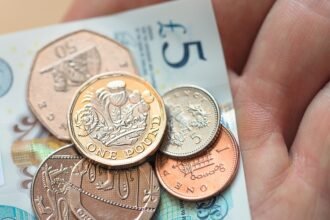The Pound Sterling (GBP) extends its losing streak against the US Dollar (USD) for the fourth trading day on Friday. The GBP/USD pair trades near its fresh over six-month low of 1.3116 posted on Thursday. The Cable has been under pressure due to a strengthening US Dollar amid easing Federal Reserve (Fed) dovish speculation for the December policy meeting and optimism on a trade deal between the United States (US) and China.
At the press time, the US Dollar Index (DXY), which tracks the Greenback’s value against six major currencies, trades firmly near an almost three-month high around 99.70 posted on Thursday.
Traders have trimmed Fed dovish bets for the December meeting after Chairman Jerome Powell ruled out hopes of another interest rate cut this year. “Another cut in December is far from assured,” Powell said in the press conference after the monetary policy announcement on Wednesday, in which the Fed reduced interest rates by 25 basis points (bps) to the 3.75%-4.00% range. This was the second interest rate cut by the Fed in a row.
According to the CME FedWatch tool, the probability of the Fed cutting interest rates by 25 bps to 3.50%-3.75% in the December meeting has eased to 72.8% from 91.1% a week ago.
Meanwhile, US Treasury Secretary Scott Bessent confirmed in an interview on Fox Business Network on Thursday that both Washington and Beijing would sign the trade deal soon. “The Kuala Lumpur agreement was finished in the middle of the night last night, so I expect we will exchange signatures possibly as soon as next week,” Bessent said, Reuters reported.
In Friday’s session, investors will focus on speeches from Fed members, Atlanta President Raphael Bostic and Cleveland President Beth Hammack, scheduled during North American trading hours.
US Dollar Price This week
The table below shows the percentage change of US Dollar (USD) against listed major currencies this week. US Dollar was the strongest against the British Pound.
| USD | EUR | GBP | JPY | CAD | AUD | NZD | CHF | |
|---|---|---|---|---|---|---|---|---|
| USD | 0.56% | 1.42% | 0.74% | 0.02% | -0.05% | 0.94% | 0.75% | |
| EUR | -0.56% | 0.88% | 0.27% | -0.54% | -0.54% | 0.37% | 0.19% | |
| GBP | -1.42% | -0.88% | -0.69% | -1.39% | -1.38% | -0.49% | -0.71% | |
| JPY | -0.74% | -0.27% | 0.69% | -0.81% | -0.87% | 0.07% | -0.09% | |
| CAD | -0.02% | 0.54% | 1.39% | 0.81% | -0.13% | 0.92% | 0.70% | |
| AUD | 0.05% | 0.54% | 1.38% | 0.87% | 0.13% | 0.91% | 0.69% | |
| NZD | -0.94% | -0.37% | 0.49% | -0.07% | -0.92% | -0.91% | -0.22% | |
| CHF | -0.75% | -0.19% | 0.71% | 0.09% | -0.70% | -0.69% | 0.22% |
The heat map shows percentage changes of major currencies against each other. The base currency is picked from the left column, while the quote currency is picked from the top row. For example, if you pick the US Dollar from the left column and move along the horizontal line to the Japanese Yen, the percentage change displayed in the box will represent USD (base)/JPY (quote).
Pound Sterling remains under pressure amid escalating UK fiscal risks
- The Pound Sterling stays under pressure against its major peers on Friday. The British currency has underperformed this week as investors worry that United Kingdom (UK) Chancellor of the Exchequer Rachel Reeves might face backlash in the upcoming budget later in November due to escalating fiscal risks.
- Lately, the UK Office for Budget Responsibility (OBR) has forecasted that the overall productivity of the economy could decline by 0.3%, a scenario that is expected to increase the fiscal budget gap by £21billion untill 2029-2030.
- The situation adds to fears that UK Chancellor Reeves would be forced to go against her own rules, which could dampen households’ confidence.
- According to the think tank of the Institute of Fiscal Studies (IFS), there is already a £22bn shortfall in the government’s finances, which could be filled either by borrowing or raising taxes on working people.
- The choice of one or a combination of both would lead Chancellor Reeves to renege on her own defined rules, as the Labour Party promised in its election manifesto that it wouldn’t increase income tax, National Insurance (NI) or VAT for working people, and also stated that the government wouldn’t borrow to fund day-to-day public spending.
Technical Analysis: Pound Sterling stabilizes below 200-day EMA
-1761895920261-1761895920263.png&w=1536&q=95)
The Pound Sterling trades vulnerably against the US Dollar near an over six-month low of around 1.3115 posted on Thursday. The outlook of the pair remains bearish as it trades below the 200-day Exponential Moving Average (EMA), which is around 1.3270.
The 14-day Relative Strength Index (RSI) extends decline below 40.00, indicating that a fresh bearish momentum has emerged.
Looking down, the psychological level of 1.3000 will act as a key support zone. On the upside, Tuesday’s high around 1.3370 will act as a key barrier.
Fed FAQs
Monetary policy in the US is shaped by the Federal Reserve (Fed). The Fed has two mandates: to achieve price stability and foster full employment. Its primary tool to achieve these goals is by adjusting interest rates.
When prices are rising too quickly and inflation is above the Fed’s 2% target, it raises interest rates, increasing borrowing costs throughout the economy. This results in a stronger US Dollar (USD) as it makes the US a more attractive place for international investors to park their money.
When inflation falls below 2% or the Unemployment Rate is too high, the Fed may lower interest rates to encourage borrowing, which weighs on the Greenback.
The Federal Reserve (Fed) holds eight policy meetings a year, where the Federal Open Market Committee (FOMC) assesses economic conditions and makes monetary policy decisions.
The FOMC is attended by twelve Fed officials – the seven members of the Board of Governors, the president of the Federal Reserve Bank of New York, and four of the remaining eleven regional Reserve Bank presidents, who serve one-year terms on a rotating basis.
In extreme situations, the Federal Reserve may resort to a policy named Quantitative Easing (QE). QE is the process by which the Fed substantially increases the flow of credit in a stuck financial system.
It is a non-standard policy measure used during crises or when inflation is extremely low. It was the Fed’s weapon of choice during the Great Financial Crisis in 2008. It involves the Fed printing more Dollars and using them to buy high grade bonds from financial institutions. QE usually weakens the US Dollar.
Quantitative tightening (QT) is the reverse process of QE, whereby the Federal Reserve stops buying bonds from financial institutions and does not reinvest the principal from the bonds it holds maturing, to purchase new bonds. It is usually positive for the value of the US Dollar.




















